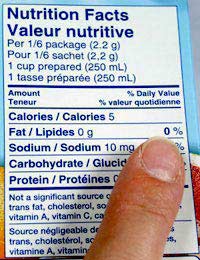How Food Labels Can Be Wrong

For some people, the path to healthy eating and a healthy tummy starts when they read food labels. But many people may not realise that food labels are not always accurate. Other factors come into play, including whether or not the food is cooked. When it comes to health and digestion, there is much debate over how important these differences in values are to health.
Importance of Food Label Accuracy
Some researchers have recently called for an overhaul of our current food labelling system. They feel it is based on very outdated science that is not only inaccurate but also misleading, particularly to those health conscious people who rely on these values.Apparently, food labels can be as much as twenty-five percent 'off' from the true values shown. This could be an overestimate or an underestimate. Most of the calories shown for foods are reflective of a system developed by Atwater, a chemist. The problem cited is that this system is too imprecise and doesn't truly reflect the process of digestion, where each food requires a different amount of energy. Food labels don't show these values.
Fibre and Protein in Food Labels
Fibre is an important part of the diet and plays a vital role in digestion and how your tummy feels as well. It also fuels microorganisms in the gut, which take some of the fibre from our foods. This affects the final value of what we get.Protein is another nutrient that is affected as it requires a great deal of energy to break protein down into individual amino acids. Some professionals are calling for calorie counts per gram of protein to be reduced, which would reflect this energy cost from digestion.
Many people just aren't aware that when we cook our food, we actually can improve how much of it we digest. While overcooking can damage micronutrients – vitamins and mineral content in food – it can make protein and fibre easier to absorb by the body. If meat is cooked, for instance, the heat breaks down the proteins, making them easier for the body to use.
Improving the Current System
One recommendation is that the system should be adjusted to be mindful of the different amounts of energy required to digest foods. Both protein and fibre content should coincide with energy used during the digestive process. Still, other nutrition professionals feel that the current system is sufficient. They cite that costs and research needed to significantly change the current system just aren't worth it for the benefits we would gain.Other professionals feel that each calorie matters. Just an extra twenty calories or so a day could translate to a kilogram of fat gained each year. With obesity rates continuing to rise and given the cost to health of being overweight, these numbers could be very important, however small they may seem.








